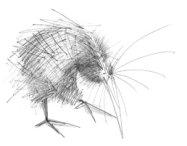About Chick Timers
Chick timers are a “smart” kiwi radio transmitter developed by a couple of clever engineers in Hawkes Bay. They were sick of doing heaps of night field work on their local kiwi recovery project checking kiwi nests to see if chicks had hatched.
These guys (John and Al of Wildtech) have taken a standard kiwi chick tx (“tx” is short hand for transmitter) with a mercury switch inside it and added some software.
The mercury switch detects movement and the software basically counts how often the kiwi moves his leg. High counts mean lots of movement. The software then interprets the trends in movement and sends out a coded signal in a data stream that we can monitor with our standard kiwi radio monitoring gear as series of beeps. We put these tx’s on the males because it is the dads that incubate the eggs after mum has made a huge effort to lay them.
When the dads are nesting their activity is usually around the 3 to 4 hour mark. This is the time it takes the dad to sneak off the nest for a quick feed each night. He usually nests for 80 days – the longest of any bird species.
This chart is the datastream for Whitu at Reotahi at 10.15am on 23 March 2010. You can click on the chart to see the data, which tells us that there were 30 beeps per minute – and that’s good, because 30 is the signal for “alive but not nesting”. It also tells us that it was 35 days since Whitu was last nesting, that he got up15 hours ago at 7.15pm, and was active for about 10 hours. Two nights ago he was active for 9.5 hours, and he averaged about 9.75 hours of activity for the past four nights!
These chick timers have been great for monitoring our kiwi. We use them on the dads in Purua that are part of the BNZ Save The Kiwi Operation Nest Egg programme to tell us when a chick has hatched and is ready to be moved to the Limestone Island kiwi crèche. They save heaps of field work time that was previously needed to visually check kiwi to see if they were nesting. These transmitters also mean the kiwi are far less likely to be disturbed by whoever is monitoring them because they can do it from a distance.













![CropperCapture[12]](http://www.backyardkiwi.org.nz/wp-content/uploads/2010/03/CropperCapture12-150x150.jpg)